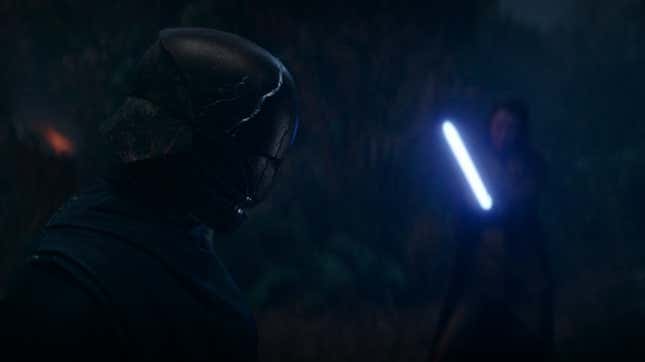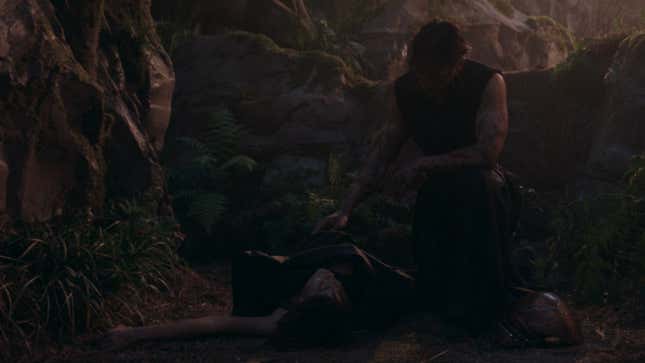There’s a lot of violence in Star Wars. But a lot of Star Wars’ violence, and its approach to it, is rooted in the abstract—whole planets gone in the blink of an eye, grand battles in space and on the ground; even on smaller scales, its duels are less about the act of violence, and more chivalrous dances. But rarely is Star Wars akin to a slasher movie.
And in “Night,” The Acolyte just gave us one hell of a Star Wars slasher.

The twin to last week’s thoughtful, but dread-laden mediation on Osha and Mae’s twin paths—coming to a fork represented by the arrival of a dark warrior we now know is only referred to as “The Stranger”—“Night” is a shocking jolt of action that both energizes and hollows out, metaphorically and literally speaking, much of what The Acolyte has been so far. On the one hand, the episode is almost entirely action, making for a narratively light episode until we get some fleeting glimpses of the series’ devastating new status quo for its back half in the final scenes. But on the other, that action is on the whole remarkably new for Star Wars: an extended saber-on-saber clash between a cadre of highly trained Jedi and something akin to a wild beast in the Stranger. “Night” presents the Stranger as a masked horror that casts aside the Vader or Kylo Ren parallels to deliver something less like the unstoppable wall of Rogue One’s corridor slaughter—again a moment that was violent, but abstract, slicing down seas of faceless soldiers—and more like a slasher stalking their prey. The tone and brutality here is unlike anything we’ve really seen presented in Star Wars on screen.

The Stranger moves unpredictably, acts unpredictably, shrugging off stun blasts with a coolness in one moment and swirling around a crimson blade with reckless, angry abandon the next. The battle is dirty, as all the rules that we feel we know about lightsaber fights in this saga—and our Jedi heroes feel alike, so honor-bound and so full of the image of themselves that they are—are thrown out the window. A helmet of a very certain kind of material—not confirmed explicitly yet, but almost definitely Cortosis, a classic EU mineral that’s quietly been a part of current canon since the 2014 novel A New Dawn—head-butted into blades to send them sputtering out, long enough to turn their wielders into headless, skewered bodies. Children, in poor Jecki’s case, cut down not with a precision execution, but deliberate, repeated strikes from a hidden blade. Heads wrenched, bones snapped, as a proud knight like Yord Fandar lifelessly crumples to the ground.
Star Wars is rarely something that allows itself to be this brutal, this horrific even, or this unpredictable. Typically it’s a saga constrained by itself, a tragedy in the dread inevitability that a lot of its stories are about providing context to other ones, so the characters shuffled between them and across various points of the timeline are by and large “safe.” Leveraging that The Acolyte is largely distant from the rest of the saga, and filled with characters we’ve never met before, mostly so you can just brutally off them just as we’re really getting to know them, is a stunningly gut-wrenching bit of work—and sets the stage for a back half to this season that has now prepared us for the idea that anything is on the table.

Not everything is quite so unpredictable in the battle, however. Jecki’s death—after a full-frontal assault by the padawan slices apart the Stranger’s mask—exposes the villain as none other than Qimir himself. It’s not a bad reveal, in fact it’s anything but. Manny Jacinto’s ability to turn on a dime from the slimy, but somewhat affable smuggler in one moment, to this violent, angry, but irrepressible being the next is sufficiently petrifying, as he plays with Sol and Mae alike. But the heavy-handedness of the last few weeks setting up that Qimir had more to him going on now feels a little clunkier in context with the reveal, especially contrasted with the strength of all this action being just how unpredictable it felt. But that doesn’t stop Qimir from delivering as barnstorming a thesis here as he does a barrage of lightsaber attacks.
Revealed to Sol, Mae, and a watching Osha—the only people left standing after the brutality we’ve just watched unfold—the not-so-strange Stranger uses the opportunity to teach both apprentice and opponent about what he really stands for, presenting a Sith perspective (perhaps not even a Sith one, as the Stranger growls to Sol; whatever he is, a Jedi would just label him Sith regardless) as a fascinating foil to the Jedi. To the Stranger, his goals are in liberation: a personal freedom, a freedom from the hypocrisy of the Jedi, from their rules, from the very idea of restraint and suppression that the Jedi believe in both religious doctrine and, as we have seen throughout this show, their political power plays as an institution. It’s not the mustache-twirling cackles and desire for power we might expect of the Dark Side, but something still just as deliciously insidious—and all the more affecting, as we see Sol’s anger turned against him and exposed, needling at all these cracks about whatever secret he is keeping from Osha and Mae alike.

In turn, it’s that repeated needling—and the sheer stakes raised by the horror they’ve both watched unfold—that as the action dies down we get an altogether different battle, as Mae and Osha finally reunite. It’s a good coda to their separate, but mirrored paths in “Day” last week, to the point it almost feels like this episode would’ve been more impactful if not split in two, an edit that makes for an awkward, but still largely effective pairing (it’d be stronger together, much like these twins!). But as Mae begs her sister to see that she still loves her, and just wants her to be free from whatever the Jedi have told her, Osha just keeps showing a dark determination that leads to tragedy: even as she hugs her sister, it’s her, not Mae, that makes the first move against the other, trying to restrain Mae and bring her in. If last week saw their paths mirrored, and come to the point in a road represented by the Stranger’s arrival on the scene, “Night” pushes both sister’s paths across each other rather literally. After Mae subdues Osha, she takes a lightsaber from the bloody battlefield and uses it to slice off the ends of her hair, disguising herself as Osha so she can flee with Sol—and it’s still up in the air if she’s doing so to get close to her final target or, perhaps, that she now sees her mission as exposing what the Jedi did on Brendok from within. And Osha herself, knocked unconscious, is left to be found by the Stranger, still yearning for a pupil and raw from Mae’s betrayal.
If Osha is truly sincere in her feelings for her sister, what does she get out of hoodwinking Sol, and leaving her to the Stranger? Will Osha’s desire for revenge blind her to whatever Mae can expose about the Jedi, and become a catalyst that will push her to become the acolyte the Stranger so desperately wants? “Night” will be remembered for its action, but this carnage is just the turning point that The Acolyte needed: the threat the Stranger represents is no longer theoretical to any party here, be it Jedi, sister, or assassin. And with Mae and Osha’s roles refracted on each other, things are only going to get messier and messier until the real truth The Acolyte seeks gets out: what is Sol still hiding, even now in the shadow of all this darkness, about that night on Brendok? How will he, Mae, Osha, and even the Stranger deal with that truth coming to light: who will repress it, and who will set it free?

As the Stranger growled to his Jedi foe and apprentices actual and potential alike, the true dichotomy of Jedi and would-be Sith is in this question—and its answer has the potential to be far more potent a battle than any brutal clash of blades could ever be.
Want more io9 news? Check out when to expect the latest Marvel, Star Wars, and Star Trek releases, what’s next for the DC Universe on film and TV, and everything you need to know about the future of Doctor Who.




















+ There are no comments
Add yours